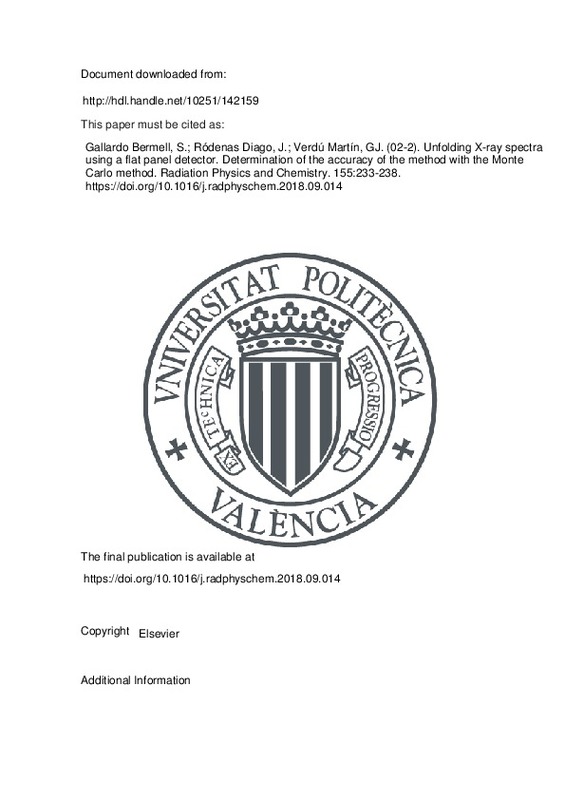JavaScript is disabled for your browser. Some features of this site may not work without it.
Buscar en RiuNet
Listar
Mi cuenta
Estadísticas
Ayuda RiuNet
Admin. UPV
Unfolding X-ray spectra using a flat panel detector. Determination of the accuracy of the method with the Monte Carlo method
Mostrar el registro sencillo del ítem
Ficheros en el ítem
| dc.contributor.author | Gallardo Bermell, Sergio
|
es_ES |
| dc.contributor.author | Ródenas Diago, José
|
es_ES |
| dc.contributor.author | Verdú Martín, Gumersindo Jesús
|
es_ES |
| dc.date.accessioned | 2020-05-04T06:28:07Z | |
| dc.date.available | 2020-05-04T06:28:07Z | |
| dc.date.issued | 2019-02 | es_ES |
| dc.identifier.issn | 0969-806X | es_ES |
| dc.identifier.uri | http://hdl.handle.net/10251/142159 | |
| dc.description.abstract | [EN] The primary X-ray spectrum depends on different parameters such as high voltage, filament current, high voltage ripple, anode angle and thickness of filter material. The objective of this work is to determine whether the unfolding technique based on the Tikhonov regularization method is accurate enough to estimate the X-ray spectrum when slight changes in the operation variables are considered. In this frame, several X-ray spectra are considered (extracted from the IPEM78 Catalogue Report) varying the main operation variables of the X-ray tube (high voltage, voltage ripple, filter thickness and filter material). With those spectra, the corresponding absorbed dose curves are obtained by simulation with a MCNP5 model reproducing a flat panel detector and a PMMA wedge. Once the absorbed dose curves are simulated and applying the unfolding Tikhonov regularization method, the unfolded spectrum is obtained, which is finally compared with the theoretical one (IPEM78 Catalogue Report). Discrepancies between unfolded and primary X-ray spectra can be attributed to the fact that this is an ill-posed problem, and the unfolding of the spectrum is strongly affected by the method used to improve the conditioning of the response function (response matrix). | es_ES |
| dc.language | Inglés | es_ES |
| dc.publisher | Elsevier | es_ES |
| dc.relation.ispartof | Radiation Physics and Chemistry | es_ES |
| dc.rights | Reserva de todos los derechos | es_ES |
| dc.subject | Discrete | es_ES |
| dc.subject | Regularization | es_ES |
| dc.subject.classification | INGENIERIA NUCLEAR | es_ES |
| dc.title | Unfolding X-ray spectra using a flat panel detector. Determination of the accuracy of the method with the Monte Carlo method | es_ES |
| dc.type | Artículo | es_ES |
| dc.type | Comunicación en congreso | es_ES |
| dc.identifier.doi | 10.1016/j.radphyschem.2018.09.014 | es_ES |
| dc.rights.accessRights | Abierto | es_ES |
| dc.contributor.affiliation | Universitat Politècnica de València. Departamento de Ingeniería Química y Nuclear - Departament d'Enginyeria Química i Nuclear | es_ES |
| dc.description.bibliographicCitation | Gallardo Bermell, S.; Ródenas Diago, J.; Verdú Martín, GJ. (2019). Unfolding X-ray spectra using a flat panel detector. Determination of the accuracy of the method with the Monte Carlo method. Radiation Physics and Chemistry. 155:233-238. https://doi.org/10.1016/j.radphyschem.2018.09.014 | es_ES |
| dc.description.accrualMethod | S | es_ES |
| dc.relation.conferencename | 10th International Topical Meeting on Industrial Radiation and Radioisotope Measurement Applications (IRRMA-X) | es_ES |
| dc.relation.conferencedate | Julio 09-13,2017 | es_ES |
| dc.relation.conferenceplace | Chicago, USA | es_ES |
| dc.relation.publisherversion | https://doi.org/10.1016/j.radphyschem.2018.09.014 | es_ES |
| dc.description.upvformatpinicio | 233 | es_ES |
| dc.description.upvformatpfin | 238 | es_ES |
| dc.type.version | info:eu-repo/semantics/publishedVersion | es_ES |
| dc.description.volume | 155 | es_ES |
| dc.relation.pasarela | S\374398 | es_ES |







![[Cerrado]](/themes/UPV/images/candado.png)

